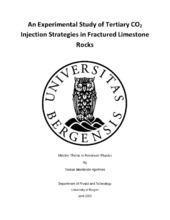| dc.description.abstract | The experimental work within this thesis is a continued investigation of tertiary recovery by injection of supercritical CO2 and CO2-foam under miscible conditions for enhanced oil recovery in fractured limestone. Secondary recovery methods in heterogeneous and fractured reservoirs can leave two-thirds of the oil behind, drawing attention to alternative injection schemes. CO2 injection is a widely established technique within the oil industry, and has been in use for over 40 years. When CO2 achieves a supercritical state, it has the properties of a gas but behaves similar to a liquid. Above the minimum miscibility pressure, interfacial tension between CO2 and the oil is eliminated, making the phases miscible. Since CO2 has much lower viscosity than water and oil, the gas-oil mobility ratio becomes unfavorable. Fingering and channeling of gas through the oil is a direct result of this, and is often considered a major problem for fractured reservoirs. Combining CO2 with water in a water- alternating-gas (WAG) process can significantly reduce mobility of CO2 and delay CO2 breakthrough. Further reduction in gas mobility may be achieved through implementation of foam. This can be done in two ways: 1) simultaneous injection of CO2 and surfactant, called co- injection. 2) surfactant-alternating-gas (SAG). A total of 13 experiments were conducted as tertiary injection methods on outcrop limestone cores in this thesis. Single CO2 and co- injection of CO2 and surfactant tests were conducted in both whole and fractured cores. One of these was a tertiary injection with integrated CO2 and CO2-foam on the same core. Tertiary WAG and SAG injections, mostly integrated on the same core, were performed to evaluate its effect on oil recovery. Injection methods were studied for both whole and fractured cores to observe the impact of fractures on different injection strategies. Experimental setups were designed to maintain conditions (90 bar and 35 <degrees>C) such that the CO2 would become supercritical and miscible with n- Decane. Results from experiments showed that pure CO2 injection had the same final recovery in whole and fractured cores, while co-injection in whole cores recovered less than in fractured cores. No significant difference was found between recovery in tertiary WAG and SAG, with 13.4 % of OOIP and 12.5 % of OOIP, respectively. The two most promising tertiary injection methods were integrated WAG and SAG with 32.4 % of OOIP, as well as integrated CO2 and co-injection with 36.2 % of OOIP. The experimental work in this thesis shows that by combining several injection strategies, in integrated EOR, more residual oil can potentially become mobilized that may not have been possible through utilization of each method individually. The timing of switching from CO2 to CO2-foam proved to be crucial at CO2 breakthrough to maximize ultimate recovery. | en_US |
